Soil Contamination Due to E-waste: A Comprehensive Report
VerifiedAdded on 2023/01/16
|9
|1962
|41
Report
AI Summary
This report investigates the significant issue of soil contamination resulting from electronic waste (e-waste). It highlights that e-waste, including items like computers and cell phones, contains numerous harmful substances that can severely impact soil health. The report presents findings showing elevated levels of heavy metals such as chromium, cadmium, copper, and lead in soil samples from e-waste sites, exceeding agricultural standards. The study proposes two primary solutions: selective extraction, which involves separating e-waste into fractions for targeted treatment, and urban mining, which focuses on reclaiming valuable components from existing e-waste in the soil. The report emphasizes the need for institutional infrastructure and government regulations to manage e-waste effectively, suggesting that increased public awareness and financial incentives are crucial for successful implementation of these solutions. This report is a valuable resource for students studying environmental engineering, providing in-depth analysis of the problem of e-waste and soil contamination.

Running Head: SOIL CONTAMINATION DUE TO E-WASTE
Soil Contamination Due to E-waste
Name
Institutional affiliation
Soil Contamination Due to E-waste
Name
Institutional affiliation
Paraphrase This Document
Need a fresh take? Get an instant paraphrase of this document with our AI Paraphraser
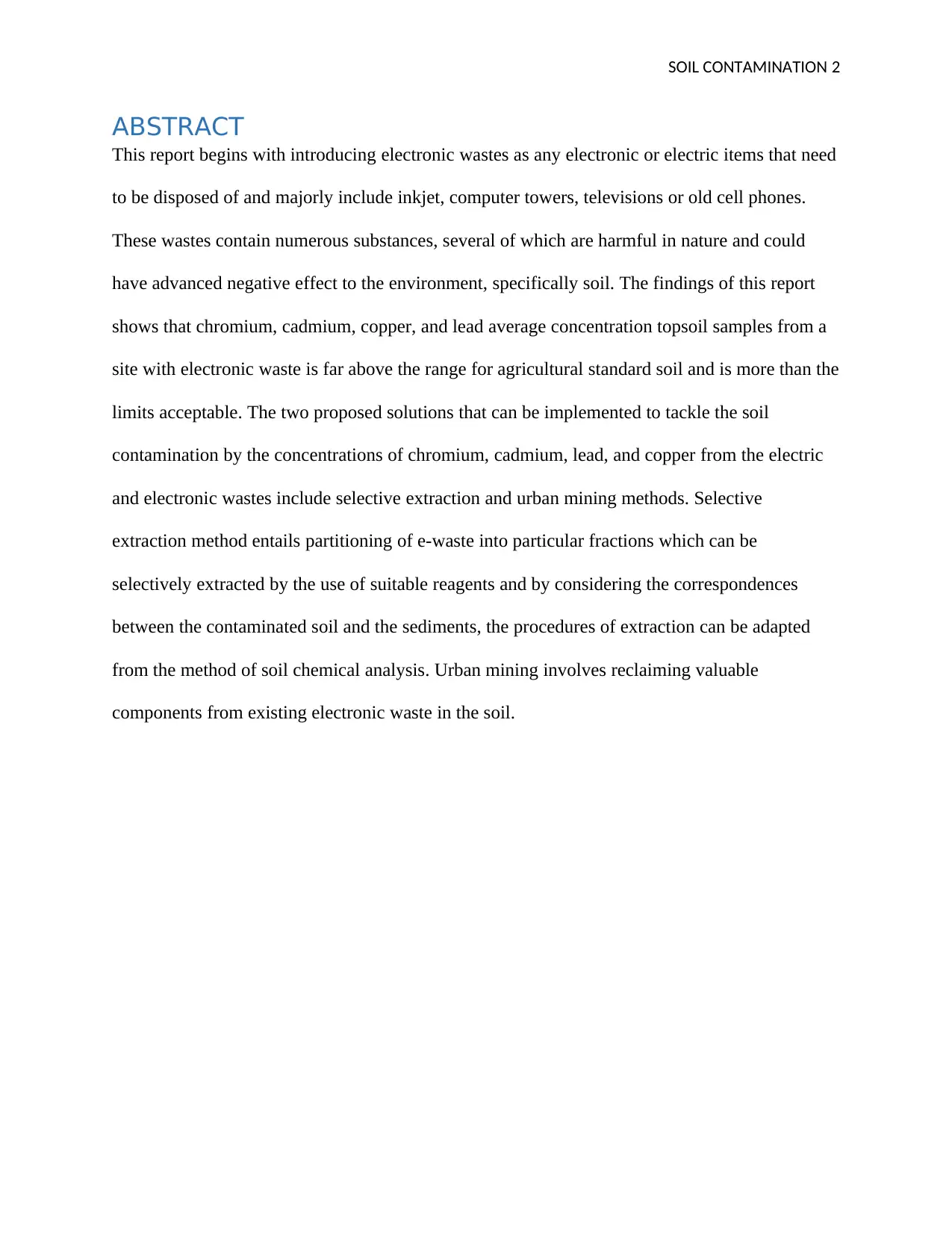
SOIL CONTAMINATION 2
ABSTRACT
This report begins with introducing electronic wastes as any electronic or electric items that need
to be disposed of and majorly include inkjet, computer towers, televisions or old cell phones.
These wastes contain numerous substances, several of which are harmful in nature and could
have advanced negative effect to the environment, specifically soil. The findings of this report
shows that chromium, cadmium, copper, and lead average concentration topsoil samples from a
site with electronic waste is far above the range for agricultural standard soil and is more than the
limits acceptable. The two proposed solutions that can be implemented to tackle the soil
contamination by the concentrations of chromium, cadmium, lead, and copper from the electric
and electronic wastes include selective extraction and urban mining methods. Selective
extraction method entails partitioning of e-waste into particular fractions which can be
selectively extracted by the use of suitable reagents and by considering the correspondences
between the contaminated soil and the sediments, the procedures of extraction can be adapted
from the method of soil chemical analysis. Urban mining involves reclaiming valuable
components from existing electronic waste in the soil.
ABSTRACT
This report begins with introducing electronic wastes as any electronic or electric items that need
to be disposed of and majorly include inkjet, computer towers, televisions or old cell phones.
These wastes contain numerous substances, several of which are harmful in nature and could
have advanced negative effect to the environment, specifically soil. The findings of this report
shows that chromium, cadmium, copper, and lead average concentration topsoil samples from a
site with electronic waste is far above the range for agricultural standard soil and is more than the
limits acceptable. The two proposed solutions that can be implemented to tackle the soil
contamination by the concentrations of chromium, cadmium, lead, and copper from the electric
and electronic wastes include selective extraction and urban mining methods. Selective
extraction method entails partitioning of e-waste into particular fractions which can be
selectively extracted by the use of suitable reagents and by considering the correspondences
between the contaminated soil and the sediments, the procedures of extraction can be adapted
from the method of soil chemical analysis. Urban mining involves reclaiming valuable
components from existing electronic waste in the soil.

SOIL CONTAMINATION 3
Table of Contents
ABSTRACT....................................................................................................................................................2
INTRODUCTION...........................................................................................................................................4
FINDINGS.....................................................................................................................................................4
DISCUSSION.................................................................................................................................................5
Selective Extraction.................................................................................................................................5
Urban Mining...........................................................................................................................................6
CONCLUSION...............................................................................................................................................7
RECOMMENDATIONS..................................................................................................................................8
REFERENCES................................................................................................................................................9
Table of Contents
ABSTRACT....................................................................................................................................................2
INTRODUCTION...........................................................................................................................................4
FINDINGS.....................................................................................................................................................4
DISCUSSION.................................................................................................................................................5
Selective Extraction.................................................................................................................................5
Urban Mining...........................................................................................................................................6
CONCLUSION...............................................................................................................................................7
RECOMMENDATIONS..................................................................................................................................8
REFERENCES................................................................................................................................................9
⊘ This is a preview!⊘
Do you want full access?
Subscribe today to unlock all pages.

Trusted by 1+ million students worldwide
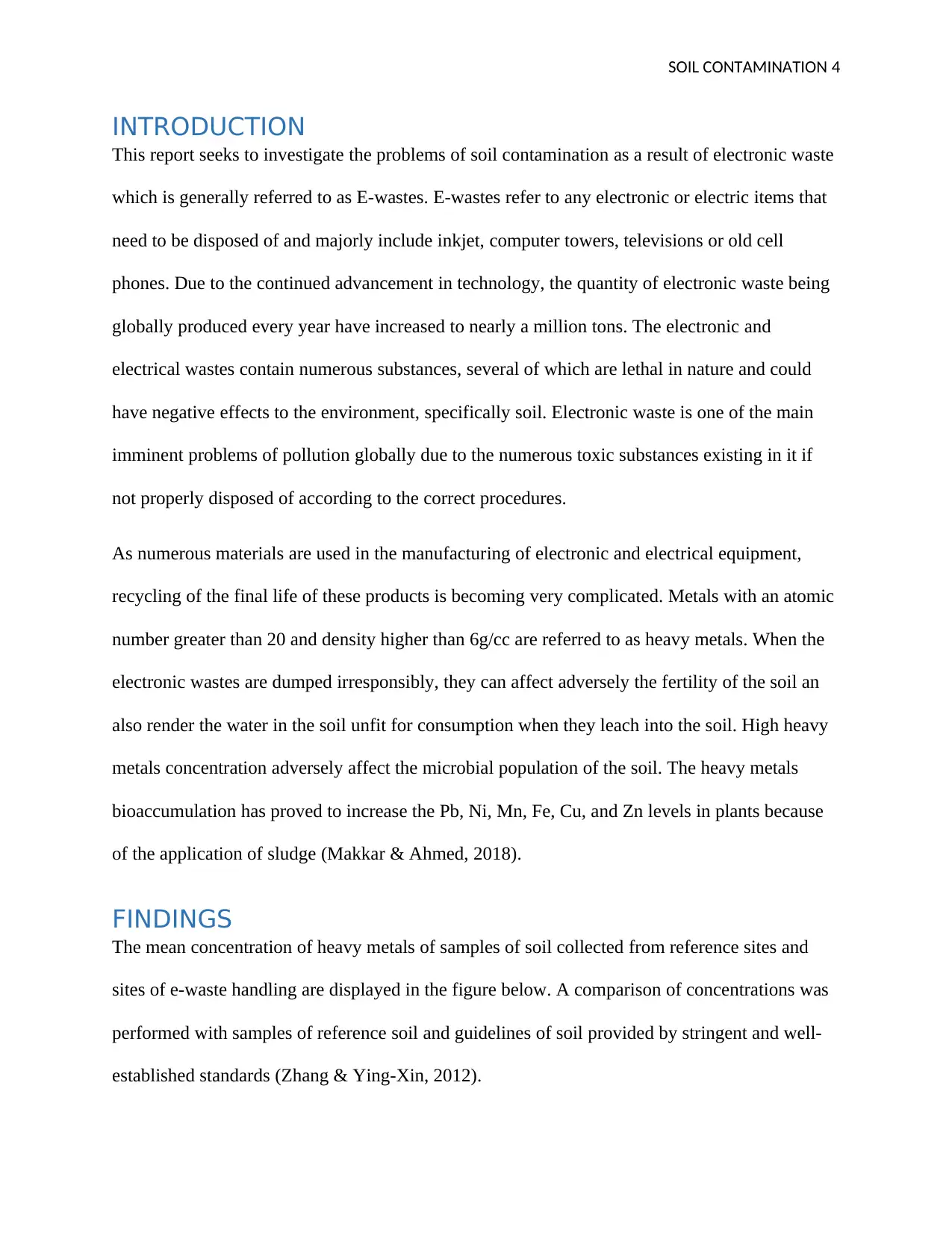
SOIL CONTAMINATION 4
INTRODUCTION
This report seeks to investigate the problems of soil contamination as a result of electronic waste
which is generally referred to as E-wastes. E-wastes refer to any electronic or electric items that
need to be disposed of and majorly include inkjet, computer towers, televisions or old cell
phones. Due to the continued advancement in technology, the quantity of electronic waste being
globally produced every year have increased to nearly a million tons. The electronic and
electrical wastes contain numerous substances, several of which are lethal in nature and could
have negative effects to the environment, specifically soil. Electronic waste is one of the main
imminent problems of pollution globally due to the numerous toxic substances existing in it if
not properly disposed of according to the correct procedures.
As numerous materials are used in the manufacturing of electronic and electrical equipment,
recycling of the final life of these products is becoming very complicated. Metals with an atomic
number greater than 20 and density higher than 6g/cc are referred to as heavy metals. When the
electronic wastes are dumped irresponsibly, they can affect adversely the fertility of the soil an
also render the water in the soil unfit for consumption when they leach into the soil. High heavy
metals concentration adversely affect the microbial population of the soil. The heavy metals
bioaccumulation has proved to increase the Pb, Ni, Mn, Fe, Cu, and Zn levels in plants because
of the application of sludge (Makkar & Ahmed, 2018).
FINDINGS
The mean concentration of heavy metals of samples of soil collected from reference sites and
sites of e-waste handling are displayed in the figure below. A comparison of concentrations was
performed with samples of reference soil and guidelines of soil provided by stringent and well-
established standards (Zhang & Ying-Xin, 2012).
INTRODUCTION
This report seeks to investigate the problems of soil contamination as a result of electronic waste
which is generally referred to as E-wastes. E-wastes refer to any electronic or electric items that
need to be disposed of and majorly include inkjet, computer towers, televisions or old cell
phones. Due to the continued advancement in technology, the quantity of electronic waste being
globally produced every year have increased to nearly a million tons. The electronic and
electrical wastes contain numerous substances, several of which are lethal in nature and could
have negative effects to the environment, specifically soil. Electronic waste is one of the main
imminent problems of pollution globally due to the numerous toxic substances existing in it if
not properly disposed of according to the correct procedures.
As numerous materials are used in the manufacturing of electronic and electrical equipment,
recycling of the final life of these products is becoming very complicated. Metals with an atomic
number greater than 20 and density higher than 6g/cc are referred to as heavy metals. When the
electronic wastes are dumped irresponsibly, they can affect adversely the fertility of the soil an
also render the water in the soil unfit for consumption when they leach into the soil. High heavy
metals concentration adversely affect the microbial population of the soil. The heavy metals
bioaccumulation has proved to increase the Pb, Ni, Mn, Fe, Cu, and Zn levels in plants because
of the application of sludge (Makkar & Ahmed, 2018).
FINDINGS
The mean concentration of heavy metals of samples of soil collected from reference sites and
sites of e-waste handling are displayed in the figure below. A comparison of concentrations was
performed with samples of reference soil and guidelines of soil provided by stringent and well-
established standards (Zhang & Ying-Xin, 2012).
Paraphrase This Document
Need a fresh take? Get an instant paraphrase of this document with our AI Paraphraser

SOIL CONTAMINATION 5
Figure 1: Heavy metals concentration in soil samples of different sites of sampling (Borůvka,
Saberioon, Kozák, & Vašát, 2016)
From the figure above, the topsoil samples of chromium, cadmium, copper, and lead average
concentration from a site with electronic waste is far above the range for agricultural standard
soil and is more than the limits allowable. The average concentration of copper is nearly 30 times
compared to the topsoil of the reference site and approximately 120 times for samples of the
subsoil. The major reason for the high concentration of copper is because of extraction of copper
from printed wiring boards and other e-wastes (Ishchenko, 2017).
DISCUSSION
This study proposes two major solutions to tackle the soil contamination by the concentrations of
chromium, cadmium, lead, and copper from the electric and electronic wastes (Makkar &
Ahmed, 2018). The two solutions are discussed below.
Selective Extraction
According to (Sridhar, Hammed, & Oyelami, 2017), the solid waste materials in contaminated
soil with e-waste can be divided into particular fractions which can be selectively extracted by
the use of suitable reagents. Through the consideration of the resemblances between the
contaminated soil and the sediments, the procedures of extraction can be adapted or borrowed
Figure 1: Heavy metals concentration in soil samples of different sites of sampling (Borůvka,
Saberioon, Kozák, & Vašát, 2016)
From the figure above, the topsoil samples of chromium, cadmium, copper, and lead average
concentration from a site with electronic waste is far above the range for agricultural standard
soil and is more than the limits allowable. The average concentration of copper is nearly 30 times
compared to the topsoil of the reference site and approximately 120 times for samples of the
subsoil. The major reason for the high concentration of copper is because of extraction of copper
from printed wiring boards and other e-wastes (Ishchenko, 2017).
DISCUSSION
This study proposes two major solutions to tackle the soil contamination by the concentrations of
chromium, cadmium, lead, and copper from the electric and electronic wastes (Makkar &
Ahmed, 2018). The two solutions are discussed below.
Selective Extraction
According to (Sridhar, Hammed, & Oyelami, 2017), the solid waste materials in contaminated
soil with e-waste can be divided into particular fractions which can be selectively extracted by
the use of suitable reagents. Through the consideration of the resemblances between the
contaminated soil and the sediments, the procedures of extraction can be adapted or borrowed
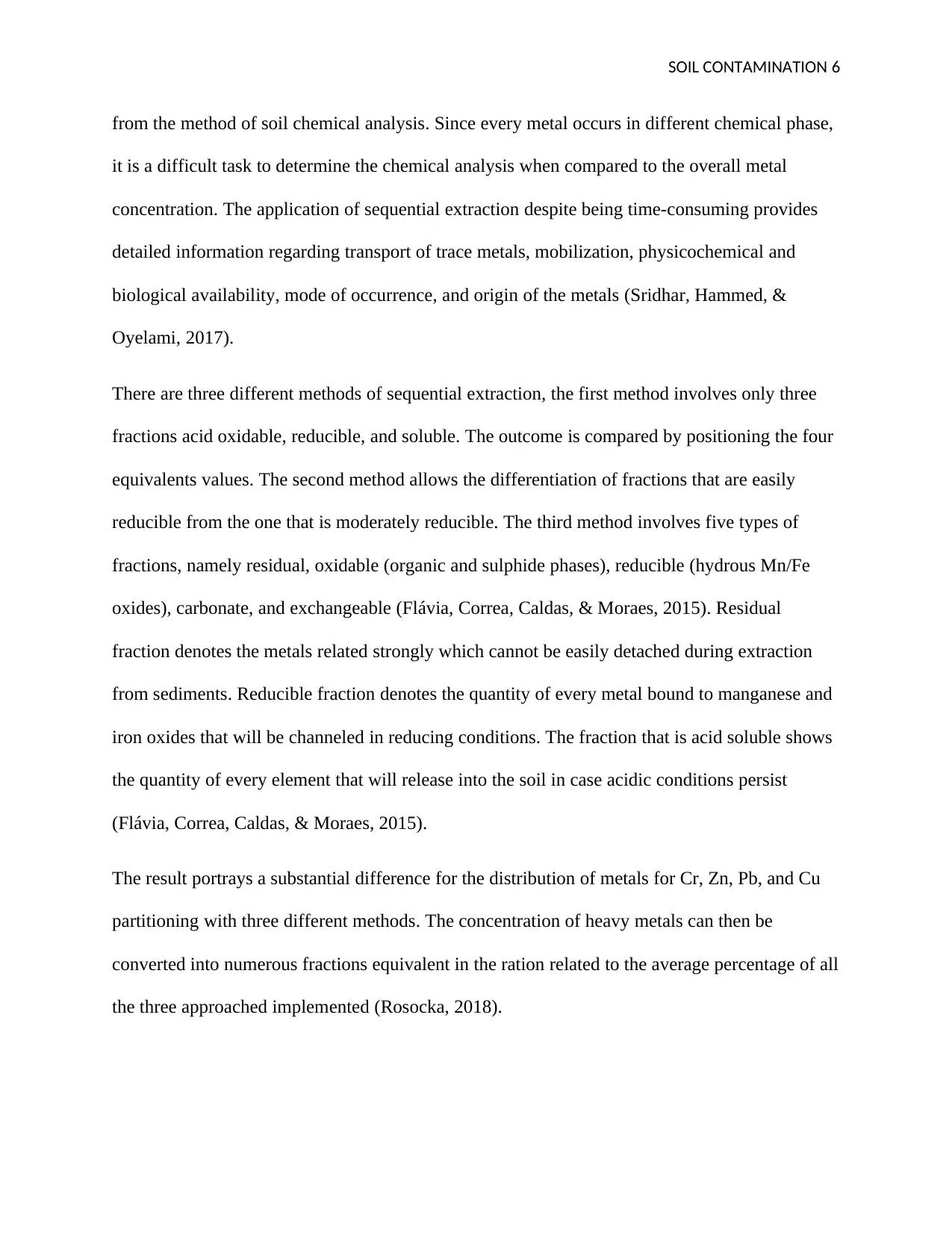
SOIL CONTAMINATION 6
from the method of soil chemical analysis. Since every metal occurs in different chemical phase,
it is a difficult task to determine the chemical analysis when compared to the overall metal
concentration. The application of sequential extraction despite being time-consuming provides
detailed information regarding transport of trace metals, mobilization, physicochemical and
biological availability, mode of occurrence, and origin of the metals (Sridhar, Hammed, &
Oyelami, 2017).
There are three different methods of sequential extraction, the first method involves only three
fractions acid oxidable, reducible, and soluble. The outcome is compared by positioning the four
equivalents values. The second method allows the differentiation of fractions that are easily
reducible from the one that is moderately reducible. The third method involves five types of
fractions, namely residual, oxidable (organic and sulphide phases), reducible (hydrous Mn/Fe
oxides), carbonate, and exchangeable (Flávia, Correa, Caldas, & Moraes, 2015). Residual
fraction denotes the metals related strongly which cannot be easily detached during extraction
from sediments. Reducible fraction denotes the quantity of every metal bound to manganese and
iron oxides that will be channeled in reducing conditions. The fraction that is acid soluble shows
the quantity of every element that will release into the soil in case acidic conditions persist
(Flávia, Correa, Caldas, & Moraes, 2015).
The result portrays a substantial difference for the distribution of metals for Cr, Zn, Pb, and Cu
partitioning with three different methods. The concentration of heavy metals can then be
converted into numerous fractions equivalent in the ration related to the average percentage of all
the three approached implemented (Rosocka, 2018).
from the method of soil chemical analysis. Since every metal occurs in different chemical phase,
it is a difficult task to determine the chemical analysis when compared to the overall metal
concentration. The application of sequential extraction despite being time-consuming provides
detailed information regarding transport of trace metals, mobilization, physicochemical and
biological availability, mode of occurrence, and origin of the metals (Sridhar, Hammed, &
Oyelami, 2017).
There are three different methods of sequential extraction, the first method involves only three
fractions acid oxidable, reducible, and soluble. The outcome is compared by positioning the four
equivalents values. The second method allows the differentiation of fractions that are easily
reducible from the one that is moderately reducible. The third method involves five types of
fractions, namely residual, oxidable (organic and sulphide phases), reducible (hydrous Mn/Fe
oxides), carbonate, and exchangeable (Flávia, Correa, Caldas, & Moraes, 2015). Residual
fraction denotes the metals related strongly which cannot be easily detached during extraction
from sediments. Reducible fraction denotes the quantity of every metal bound to manganese and
iron oxides that will be channeled in reducing conditions. The fraction that is acid soluble shows
the quantity of every element that will release into the soil in case acidic conditions persist
(Flávia, Correa, Caldas, & Moraes, 2015).
The result portrays a substantial difference for the distribution of metals for Cr, Zn, Pb, and Cu
partitioning with three different methods. The concentration of heavy metals can then be
converted into numerous fractions equivalent in the ration related to the average percentage of all
the three approached implemented (Rosocka, 2018).
⊘ This is a preview!⊘
Do you want full access?
Subscribe today to unlock all pages.

Trusted by 1+ million students worldwide
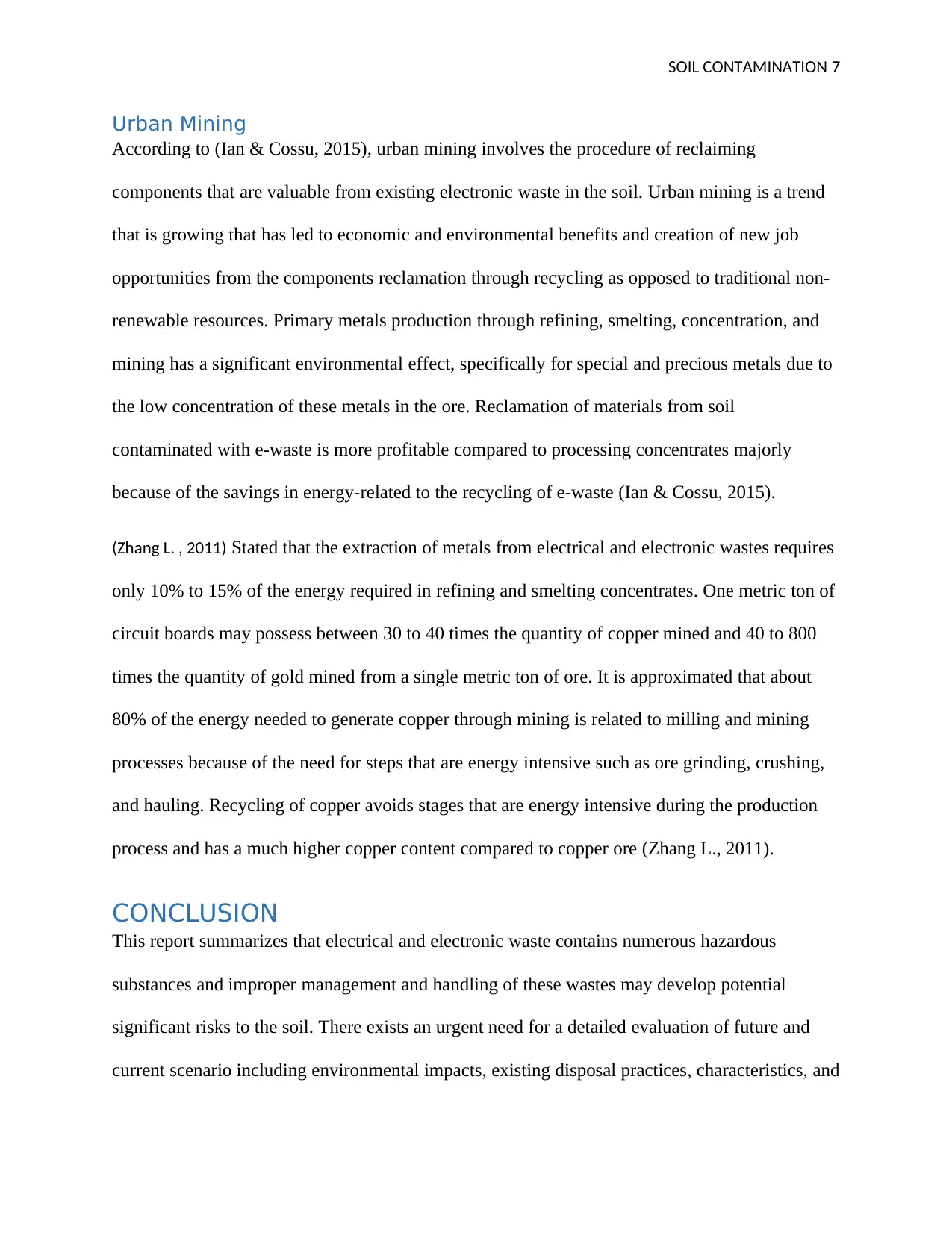
SOIL CONTAMINATION 7
Urban Mining
According to (Ian & Cossu, 2015), urban mining involves the procedure of reclaiming
components that are valuable from existing electronic waste in the soil. Urban mining is a trend
that is growing that has led to economic and environmental benefits and creation of new job
opportunities from the components reclamation through recycling as opposed to traditional non-
renewable resources. Primary metals production through refining, smelting, concentration, and
mining has a significant environmental effect, specifically for special and precious metals due to
the low concentration of these metals in the ore. Reclamation of materials from soil
contaminated with e-waste is more profitable compared to processing concentrates majorly
because of the savings in energy-related to the recycling of e-waste (Ian & Cossu, 2015).
(Zhang L. , 2011) Stated that the extraction of metals from electrical and electronic wastes requires
only 10% to 15% of the energy required in refining and smelting concentrates. One metric ton of
circuit boards may possess between 30 to 40 times the quantity of copper mined and 40 to 800
times the quantity of gold mined from a single metric ton of ore. It is approximated that about
80% of the energy needed to generate copper through mining is related to milling and mining
processes because of the need for steps that are energy intensive such as ore grinding, crushing,
and hauling. Recycling of copper avoids stages that are energy intensive during the production
process and has a much higher copper content compared to copper ore (Zhang L., 2011).
CONCLUSION
This report summarizes that electrical and electronic waste contains numerous hazardous
substances and improper management and handling of these wastes may develop potential
significant risks to the soil. There exists an urgent need for a detailed evaluation of future and
current scenario including environmental impacts, existing disposal practices, characteristics, and
Urban Mining
According to (Ian & Cossu, 2015), urban mining involves the procedure of reclaiming
components that are valuable from existing electronic waste in the soil. Urban mining is a trend
that is growing that has led to economic and environmental benefits and creation of new job
opportunities from the components reclamation through recycling as opposed to traditional non-
renewable resources. Primary metals production through refining, smelting, concentration, and
mining has a significant environmental effect, specifically for special and precious metals due to
the low concentration of these metals in the ore. Reclamation of materials from soil
contaminated with e-waste is more profitable compared to processing concentrates majorly
because of the savings in energy-related to the recycling of e-waste (Ian & Cossu, 2015).
(Zhang L. , 2011) Stated that the extraction of metals from electrical and electronic wastes requires
only 10% to 15% of the energy required in refining and smelting concentrates. One metric ton of
circuit boards may possess between 30 to 40 times the quantity of copper mined and 40 to 800
times the quantity of gold mined from a single metric ton of ore. It is approximated that about
80% of the energy needed to generate copper through mining is related to milling and mining
processes because of the need for steps that are energy intensive such as ore grinding, crushing,
and hauling. Recycling of copper avoids stages that are energy intensive during the production
process and has a much higher copper content compared to copper ore (Zhang L., 2011).
CONCLUSION
This report summarizes that electrical and electronic waste contains numerous hazardous
substances and improper management and handling of these wastes may develop potential
significant risks to the soil. There exists an urgent need for a detailed evaluation of future and
current scenario including environmental impacts, existing disposal practices, characteristics, and
Paraphrase This Document
Need a fresh take? Get an instant paraphrase of this document with our AI Paraphraser
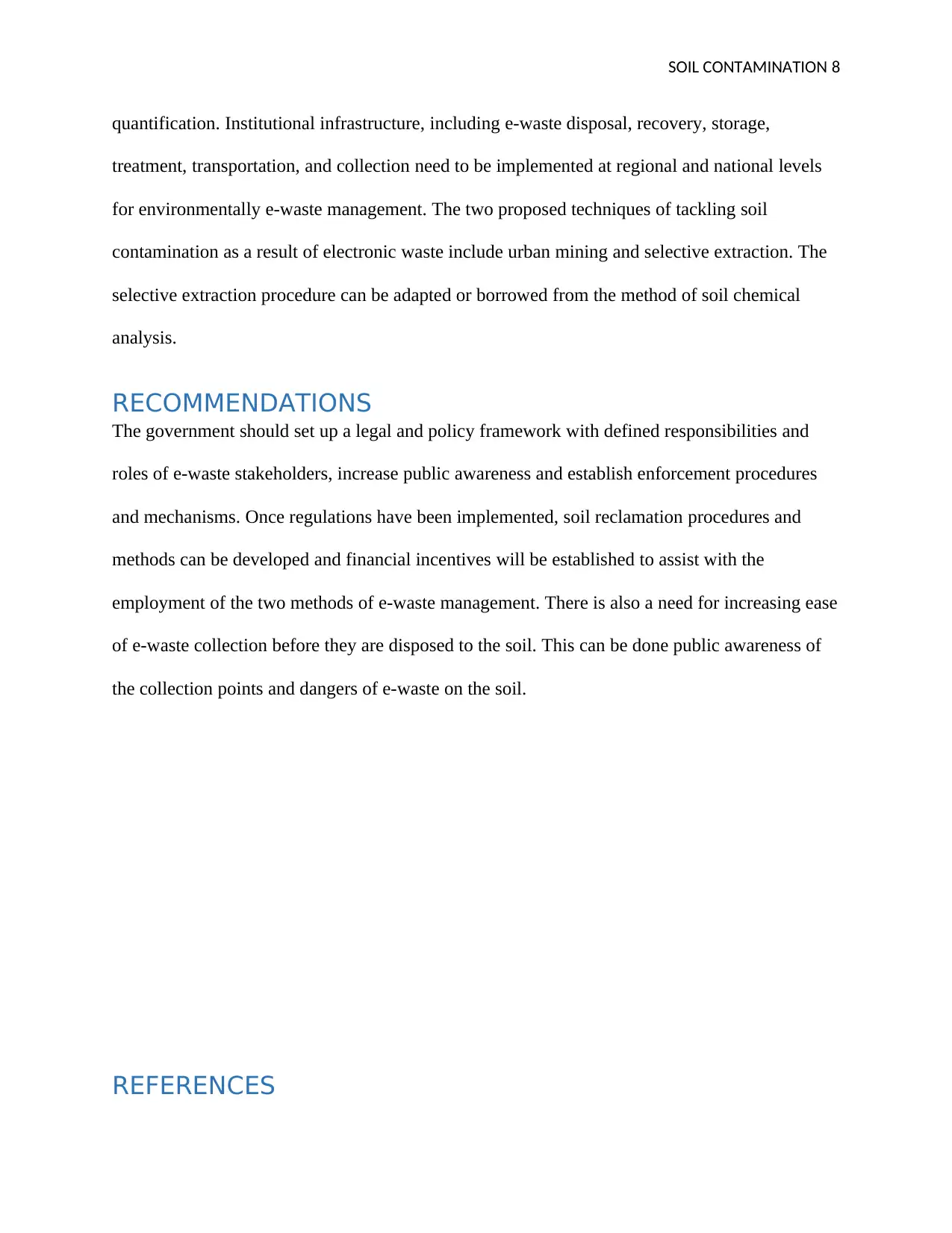
SOIL CONTAMINATION 8
quantification. Institutional infrastructure, including e-waste disposal, recovery, storage,
treatment, transportation, and collection need to be implemented at regional and national levels
for environmentally e-waste management. The two proposed techniques of tackling soil
contamination as a result of electronic waste include urban mining and selective extraction. The
selective extraction procedure can be adapted or borrowed from the method of soil chemical
analysis.
RECOMMENDATIONS
The government should set up a legal and policy framework with defined responsibilities and
roles of e-waste stakeholders, increase public awareness and establish enforcement procedures
and mechanisms. Once regulations have been implemented, soil reclamation procedures and
methods can be developed and financial incentives will be established to assist with the
employment of the two methods of e-waste management. There is also a need for increasing ease
of e-waste collection before they are disposed to the soil. This can be done public awareness of
the collection points and dangers of e-waste on the soil.
REFERENCES
quantification. Institutional infrastructure, including e-waste disposal, recovery, storage,
treatment, transportation, and collection need to be implemented at regional and national levels
for environmentally e-waste management. The two proposed techniques of tackling soil
contamination as a result of electronic waste include urban mining and selective extraction. The
selective extraction procedure can be adapted or borrowed from the method of soil chemical
analysis.
RECOMMENDATIONS
The government should set up a legal and policy framework with defined responsibilities and
roles of e-waste stakeholders, increase public awareness and establish enforcement procedures
and mechanisms. Once regulations have been implemented, soil reclamation procedures and
methods can be developed and financial incentives will be established to assist with the
employment of the two methods of e-waste management. There is also a need for increasing ease
of e-waste collection before they are disposed to the soil. This can be done public awareness of
the collection points and dangers of e-waste on the soil.
REFERENCES
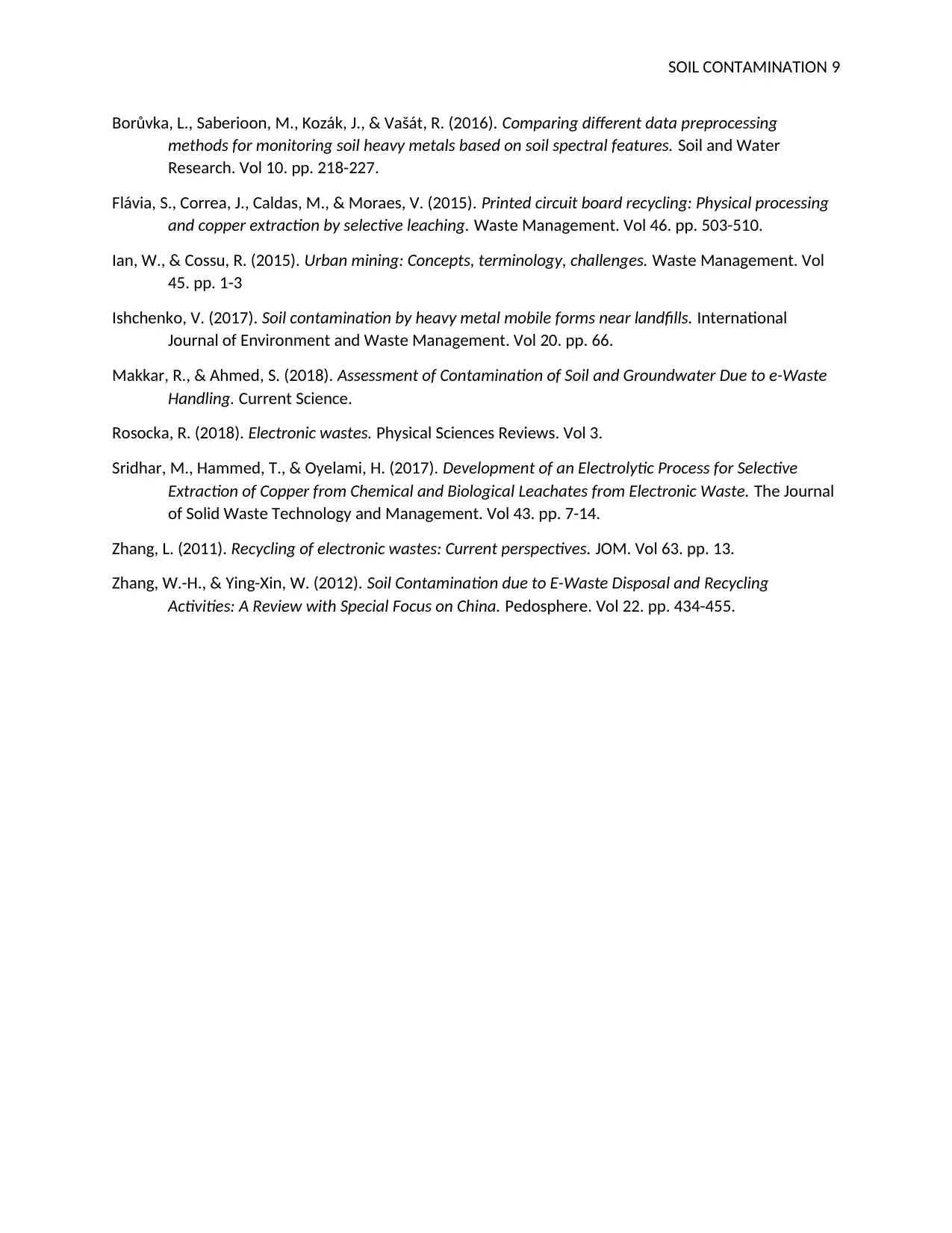
SOIL CONTAMINATION 9
Borůvka, L., Saberioon, M., Kozák, J., & Vašát, R. (2016). Comparing different data preprocessing
methods for monitoring soil heavy metals based on soil spectral features. Soil and Water
Research. Vol 10. pp. 218-227.
Flávia, S., Correa, J., Caldas, M., & Moraes, V. (2015). Printed circuit board recycling: Physical processing
and copper extraction by selective leaching. Waste Management. Vol 46. pp. 503-510.
Ian, W., & Cossu, R. (2015). Urban mining: Concepts, terminology, challenges. Waste Management. Vol
45. pp. 1-3
Ishchenko, V. (2017). Soil contamination by heavy metal mobile forms near landfills. International
Journal of Environment and Waste Management. Vol 20. pp. 66.
Makkar, R., & Ahmed, S. (2018). Assessment of Contamination of Soil and Groundwater Due to e-Waste
Handling. Current Science.
Rosocka, R. (2018). Electronic wastes. Physical Sciences Reviews. Vol 3.
Sridhar, M., Hammed, T., & Oyelami, H. (2017). Development of an Electrolytic Process for Selective
Extraction of Copper from Chemical and Biological Leachates from Electronic Waste. The Journal
of Solid Waste Technology and Management. Vol 43. pp. 7-14.
Zhang, L. (2011). Recycling of electronic wastes: Current perspectives. JOM. Vol 63. pp. 13.
Zhang, W.-H., & Ying-Xin, W. (2012). Soil Contamination due to E-Waste Disposal and Recycling
Activities: A Review with Special Focus on China. Pedosphere. Vol 22. pp. 434-455.
Borůvka, L., Saberioon, M., Kozák, J., & Vašát, R. (2016). Comparing different data preprocessing
methods for monitoring soil heavy metals based on soil spectral features. Soil and Water
Research. Vol 10. pp. 218-227.
Flávia, S., Correa, J., Caldas, M., & Moraes, V. (2015). Printed circuit board recycling: Physical processing
and copper extraction by selective leaching. Waste Management. Vol 46. pp. 503-510.
Ian, W., & Cossu, R. (2015). Urban mining: Concepts, terminology, challenges. Waste Management. Vol
45. pp. 1-3
Ishchenko, V. (2017). Soil contamination by heavy metal mobile forms near landfills. International
Journal of Environment and Waste Management. Vol 20. pp. 66.
Makkar, R., & Ahmed, S. (2018). Assessment of Contamination of Soil and Groundwater Due to e-Waste
Handling. Current Science.
Rosocka, R. (2018). Electronic wastes. Physical Sciences Reviews. Vol 3.
Sridhar, M., Hammed, T., & Oyelami, H. (2017). Development of an Electrolytic Process for Selective
Extraction of Copper from Chemical and Biological Leachates from Electronic Waste. The Journal
of Solid Waste Technology and Management. Vol 43. pp. 7-14.
Zhang, L. (2011). Recycling of electronic wastes: Current perspectives. JOM. Vol 63. pp. 13.
Zhang, W.-H., & Ying-Xin, W. (2012). Soil Contamination due to E-Waste Disposal and Recycling
Activities: A Review with Special Focus on China. Pedosphere. Vol 22. pp. 434-455.
⊘ This is a preview!⊘
Do you want full access?
Subscribe today to unlock all pages.

Trusted by 1+ million students worldwide
1 out of 9
Your All-in-One AI-Powered Toolkit for Academic Success.
+13062052269
info@desklib.com
Available 24*7 on WhatsApp / Email
![[object Object]](/_next/static/media/star-bottom.7253800d.svg)
Unlock your academic potential
Copyright © 2020–2025 A2Z Services. All Rights Reserved. Developed and managed by ZUCOL.


